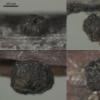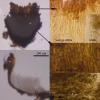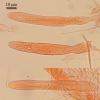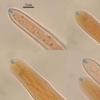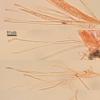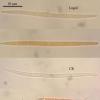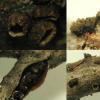
20-12-2025 23:08
Patrice TANCHAUDBonsoir, récolte sur sol sablonneux dans l'arri�

20-12-2025 15:47
Mirek GrycHi.These grew on pine wood that was heavily covere

18-12-2025 21:17
Pol DebaenstThe identification took me to Byssonectria deformi

15-12-2025 07:09
 Danny Newman
Danny Newman
indet. Rutstroemiaceae sp. on unk. fallen leavesMc

19-12-2025 10:10
Patrice TANCHAUDBonjour, récolte réalisée en milieu dunaire, a

18-12-2025 17:23
 Bruno Coué
Bruno Coué
Bonjour,je serais heureux d'avoir votre avis sur c

18-12-2025 18:07
Margot en Geert VullingsThese plumes were found on rotten wood.They strong

17-12-2025 18:35
 Michel Hairaud
Michel Hairaud
Bonjour à tous/Hi to everyone I am passing along
Apos deep-cupulate (with small pore when young), sessile or with short stipe, up to 0,7 mm in diam, single, without stroma, bursting through the bark of twigs; outer surface coriaceous, dark brown, radially splitted when overmature, hymenium grayish.
Excipulum from textura prismatica, at the base amorphous, almost black, easily crashed when tapped, in mid-length from brown prismatic cells 10-15 x 7-9mk, in collar (part exceeding hymenium) from two layers: external layer from brown textura prismatica, internal layer from textura oblita-gelatinosa, inner hyphae covered by warts to 2 mk high; medulla from textura porrecta, hyphae parralel to flanks, not conspicuous; asci cylindrical, enlarged in mid-length, with short stalk and clamp, with amyloid pore (KOH, lugol), 80-107 x 8,3-12,2; paraphyses filiform (1 mk),not ecxeeding the asci, septate, rarely branched, upper part slightly enlarged (2 mk), with some gelatinose encrustation; spores needle-shaped, with obtuse and acute ends, up to 7-septate, often start to germinate from upper end, 56 (46-66) x 2,6 (2-3).

I will send you Groves discussion on G. cassandrae and G callunigera so you can make your own decision, both species are unknown to me.
Stip
i think that it is G. cassandrae f. cassandrae. I've microscopied one more specimen, did more measurements of asci and spores.
There they are: asci 75-120 x 6,8-9,9 (N=20); spores 59 (48-71) x 2,5 (2-3,2) (N=30).
It is only about the first specimen, and i have no collection of the second (only photo of apothecia and some microphoto, where spores not showed well). So, i can't measure the second specimen and think it is impossible to say anything about species. Groves (1965) reportes that both species (G. callunigera f. cassandrae and G. cassandrae f. cassandrae) could be found on this substrate. Callunigera must have smaller spores, and mine just in range of G. cassandrae.

thank you very much for sharing your conclusion.
Stip

